
Common name:Olive
Botanical name:Olea europaea
This broad tree will grow to 40' tall and has small, gray green leaves with fleshy black fruit that appears in fall. Purchase fruitless varieties to avoid the mess.
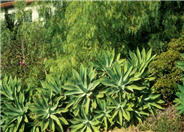
Common name:Fox Tail Agave, Velvet Agave
Botanical name:Agave attenuata
This Agave has a dramatic tropical form. Even light frost can damage its succulent leaves. It is great for containers. In the low desert, partial sun will be best. If it becomes top heavy, simply cut and stick in the ground to root. It is not a fast grower and has light green foliage. It will also die after flowering but pups around the mother will survive. Distinctive with its large rosette of leaves perched on a long curving trunk, it is a native from Mexico.
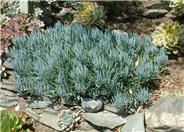
Common name:Kleinia
Botanical name:Senecio mandraliscae
This succulent perennial will grow to about 1.5' tall and 2' wide. It has curved, bluish gray leaves that are about 3.5" long and very slender.
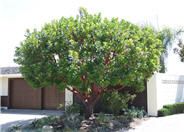
Common name:Strawberry Madrone
Botanical name:Arbutus 'Marina'
The 'Marina' has gorgeous bark, with leaves that are smaller and not as glossy as Pacific Madrone. Its flowers are pink, borne in pendant clusters in the summer. The fruit is large, red and quite ornamental. The plant should be grown in sun to part shade, with little or no summer watering when established. The 'Marina' prefers good drainage.
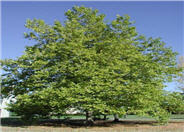
Common name:London Plane Tree
Botanical name:Platanus X acerifolia
London Plane Tree is a fast growing, deciduous tree that reaches a size 40'-80' high by 30'-40' wide. Its leaves are 3-5 lobed, with a width of 4"-10". This plant is tolerant of most soils, smog, dust and reflected heat.
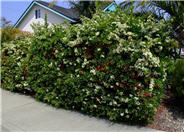
Common name:Santa Cruz Pyracantha
Botanical name:Pyracantha koidzumii 'Santa Cruz'
The 'Santa Cruz' is a low growing variety to 3'-6" tall and spreading to 5'-6' across and bearing plentiful bright red berries.
| Designer: My Botanica | Agaves and Trees |
Photographer: GardenSoft |
Soils and Compost:
Maintain a two to four inch layer of mulch on the soil surface to reduce weeds, infiltrate rain water, and reduce compaction.
Water Saving Tip:
Check your irrigation system for breaks, leaks and problems once a month.
Integrated Pest Management:
Remove irrigation water and fertilizer from areas where you don't want weeds to grow.

